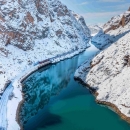

7 Incredible Forests In Europe You Can Reach By Train
There is something arrestingly tranquil and yet strangely tense about walking through a vast, unspoilt forest. Perhaps it has to do with strange conflict of being alone, and yet feeling ominously observed, if only by nature. Forested land covers more than 35% of Europe.
Though many of these regions are difficult to reach by train, here are seven spectacular forests in Europe that are accessible by rail.
1. Black Forest, Germany

Germany’s Black Forest is perhaps central Europe’s most famous forest. This stunning mountainous region in south-west Germany has it all — dense evergreen forests, dramatic mountains, and quaint villages. It is home to cuckoo clocks dating back to the 1700s, and many villages feel eerily stuck in a distant time. The fairy-tale atmosphere lends itself perfectly to full escapism from the real world.
How to get there by train: One of the best ways to experience the Black Forest is by train. Its line runs between Offenburg and Konstanz. It offers incredible views of the region and stops in several towns along the way.
2. Wild Taiga, Finland

Finland is packed full of natural beauty, and the Wild Taiga forests are no exception. This pristine attraction in Finland’s north east has a rich culture and traditions, but many also flock to it for the views, wildlife and both summer and winter activities. Though peaceful and remote, there is a definite sense of calm and safety while in the reaches of this vast reserve.
How to get there by train: The main railway route from Helsinki connects via the town of Kuopio to Kajaani. Depending on the route, the journey takes between 5 and 7 hours.
3. Białowieża Forest, Poland

Much of Poland is still unspoilt forest, though this may just be set to change. The Białowieża forest is one of the last remaining parts of an ancient forest that used to stretch across the European Plain. Though the country has started logging in the region, there are still stretches that are largely unspoilt. Aside from the sheer beauty of this primaeval forest, there is also a chance to spot European bison.
How to get there by train: The closest train station to the forest is Hajnowka, just one kilometre away. The journey there from Warsaw requires a transfer and takes approximately 4h 30m.
4. Hallerbos Forest, Belgium

Hallerbos Forest, or “The Blue Forest”, is a stunning forest perfect for long scenic hikes. The vast carpets of bluebells which pop up in mid-April each year give the beautiful forest its name. There are also giant Sequoia trees that make a visit to this beautiful stretch of land a humbling and rejuvenating experience.
How to get there by train: There are regular trains from Brussels to Halle that take just 16 minutes. From there, if it is a weekday, catch TEC bus number 114 to get to the forest entrance. If you are visiting on the weekend, bus number 156 or 155 will take you there.
5. Plitvice Lakes, Croatia

Croatia’s Plitvice Lakes National Park is best known for its stunning natural lakes, but many overlook the unspoilt forests surrounding the attraction. The national park area consists of 16 terraced lakes and several waterfalls that filter down into a dramatic limestone canyon. Though a popular tourist attraction, the lakes and surrounding forests are still one of Europe’s most celebrated natural attractions.
How to get there by train: The easiest way to reach the lakes is to catch a train to the capital Zagreb. From there, several daily buses connect you directly to the park in approximately two hours.
6. Saxon Switzerland National Park, Germany

Despite its confusing name, Saxon Switzerland National Park is very much in Germany. It is a vast natural region that borders with north-western Czech Republic. It is the country’s only rock national park, but it is also covered in remarkable forests. Many head to the region to hike, but there is also a fascinating history to explore, including the Königstein Fortress.
How to get there by train: The nearest big city to the park is Dresden, which is easy to reach by rail from much of Germany. From there, you can take the S-Bahn and a tram.
7. Triglav National Park, Slovenia

Slovenia is one of the most forested countries in Europe, much of which is inaccessible to trains. But the gateway to the region, Lake Bohinj, is easy to reach from the capital. This beautiful lake is surrounded by towering mountains and dense forest. Many choose to spend their time there around the lake, but there are several stunning and serene walks through the valleys and up into the trees as well.
How to get there by train: The easy way to access the park by train is via Bohinjska Bistrica. There are regular trains there via Jesenice that take approximately 3 hours. Once there, regular buses can connect you to the lake and forests.
Though visiting natural attractions such as forests can be complex on a rail journey, that is no reason to exclude them. These natural attractions offer the perfect contrast to the busy cities, and with just a bit of research, you will find they are surprisingly convenient to reach with your Global Pass in hand.
You might like this as well:
-
![wood-forest-trees]() 7 Incredible Forests In Europe You Can Reach By Train Love nature? Here are seven spectacular forests in Europe that are accessible by rail. with an Interrail or Eurail Pass.
7 Incredible Forests In Europe You Can Reach By Train Love nature? Here are seven spectacular forests in Europe that are accessible by rail. with an Interrail or Eurail Pass. -
![iceland-old-house-landscape-sea-mountains]() Europe’s Most Beautiful Places For Nature Ready for the ultimate rail adventure in Europe? Here are 7 picture-perfect destinations for nature that are worth the detour with the Interrail Global Pass.
Europe’s Most Beautiful Places For Nature Ready for the ultimate rail adventure in Europe? Here are 7 picture-perfect destinations for nature that are worth the detour with the Interrail Global Pass.
Change of currency
You cannot change the currency once you have a Pass in your cart. Remove the Pass, and then change the currency on the website header.







